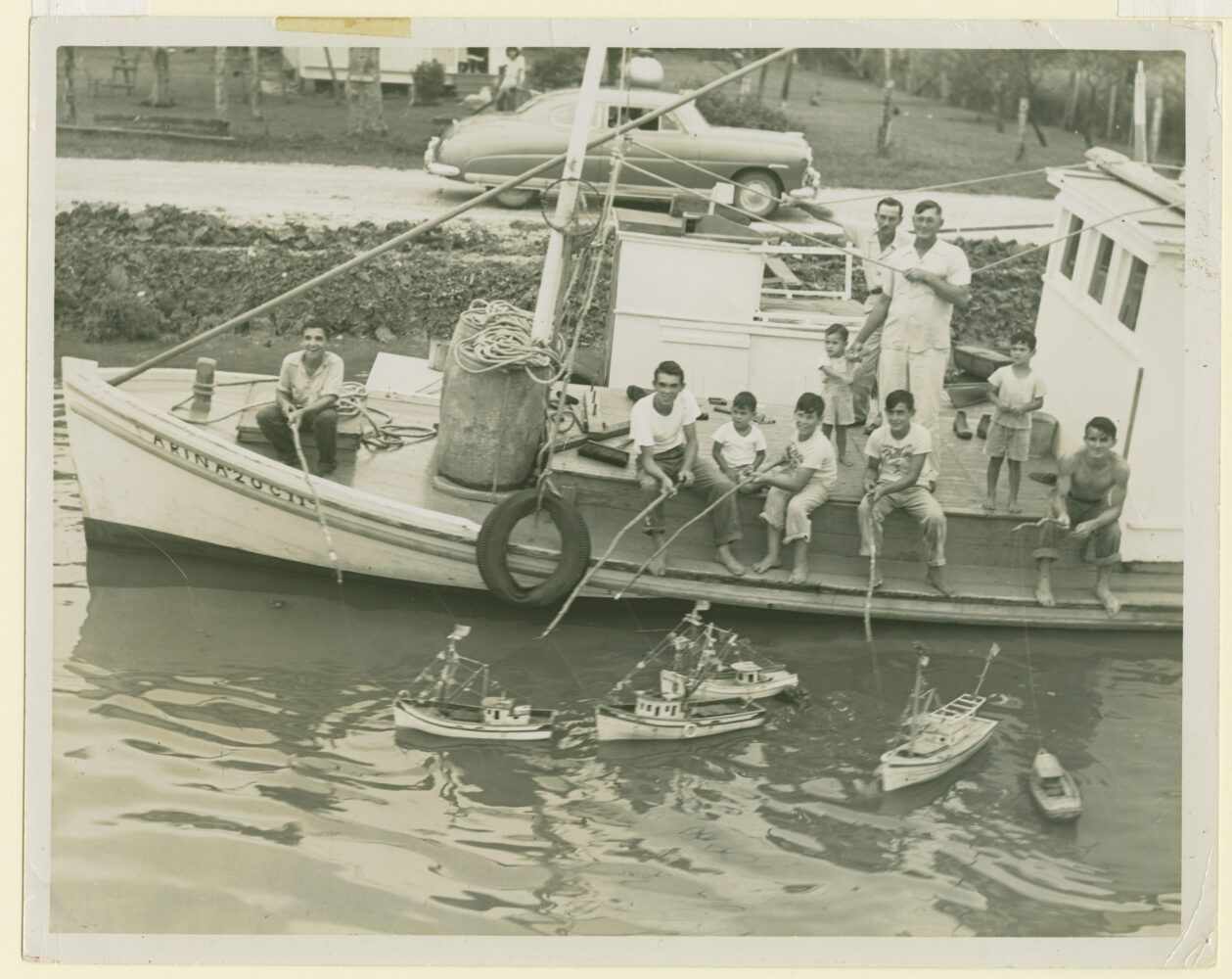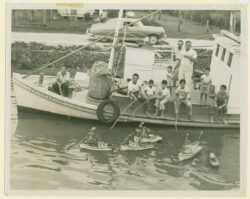Blessings of the Fleet
At Boat Blessings, a Catholic priest blesses a community’s shrimp boats before the start of shrimp season

Photo by Roby's Photo Studio, The Historic New Orleans Collection
Boys with miniature shrimp lugger at the blessing of the shrimp fleet, Chauvin, La., 1940s.
Blessings of the Fleet, also called Boat Blessings, are annual events that occur in various communities across Louisiana’s coast wherein a Catholic priest blesses a community’s shrimp boats before the start of one of the two inshore shrimp seasons. The boats display various decorations for the event and assemble together as a “fleet” in a boat parade. This parade typically occurs after a special Fishermen’s Mass conducted at the priest’s church.
However, the specifics of the practice can differ greatly between communities and across history. In some cases the Blessing of the Fleet is a small, community-focused affair, while other times it can attract tens of thousands of outsiders. The Blessing of the Fleet can also be a cornerstone activity in several days of related events which might include fairs, dances, and pageants.
Although their exact origins are uncertain, Blessings of the Fleet are practiced across the world and likely spread alongside Catholicism during European colonization. They took their place of prominence in South Louisiana in the early twentieth century coinciding with technological innovations in the shrimping industry, such as the introduction of the otter trawl and motorized watercraft, which catapulted the industry’s importance in the regional economy. Our Lady of Prompt Succor church in Golden Meadow claims the oldest consecutive Blessing of the Fleet tradition on the Gulf Coast, starting in 1916. Over two decades later, in 1937, the state’s now-largest Blessing of the Fleet was added as an event of the Morgan City Shrimp Festival, which would later become known as the Shrimp and Petroleum Festival.
The Blessing of the Fleet customarily occurs before the start of one of the two inshore shrimp seasons (spring and fall), the exact dates of which are set by the Louisiana Department of Wildlife and Fisheries. Sometimes adjacent communities will schedule their blessings on different dates so participants and viewers can attend multiple nearby events. A Fisherman’s Mass, held at the blessing’s associated Catholic church, often precedes the event. Afterwards, the priest, and adjacent church functionaries such as visiting priests, deacons, and Knights of Columbus, reconvene at a nearby wharf for the boat parade and actual blessing. There, the priest either stays and blesses boats in the parade as they pass by, or he boards the “lead boat” and descends the nearby bayou, blessing passing boats that then fall in behind the procession. Being the owner of a lead boat confers a certain amount of prestige, and the boat selection generally rotates annually. For instance, in Chauvin, lead boats were historically picked by winning a decoration competition for the boat parade the year before. If the priest rides on the lead boat, a remembrance for fishermen who died at sea is sometimes held at the end of the parade before he turns back. In many cases, the parade ends in a large maritime party. For example, both the Grand Caillou/Dulac and Chauvin parades traditionally end in an afterparty on Lake Boudreaux.
Participating boats are affixed with decorations the night before or morning of the blessings. In the past, elaborate decorations could take months of planning and often contributed to a particular theme decided annually, such as Disney characters or Biblical stories. However, today’s boats largely eschew the ornate themed designs in favor of colored flags on strings attached to the mast, rigging, and hull. Large boats, especially the lead boat, often hosted bands for the parade, although sound systems have almost exclusively replaced live music. Ample spreads of food, especially boiled seafood, are also common on larger boats. Though shrimp boats are normally the focal point of the blessings, other working boats, such as tugboats, and pleasure craft increasingly join the event in modern times, the prominence of the latter having become especially visible as the shrimping industry struggles to maintain its economic viability.
Larger blessings often include auxiliary events such as dances, concerts, fairs, or pageants throughout the same weekend. Royal courts and pageants for a King and/or Queen are common for these bigger festivals. There may also be other competitions, such as cook-offs or rope throws. For smaller blessings with more locally concentrated participants and viewers, parties of family and friends boiling seafood are common sights along the bayous as the boat parade sails by.
Contemporary Blessing of the Fleets in Louisiana include (from west to east): Delcambre, Morgan City, Bayou Dularge, Grand Caillou/Dulac, Chauvin, Pointe-aux-Chenes, Des Allemands, Golden Meadow, Grand Isle, Jean Lafitte, Chalmette, Delacroix Island, and Empire.
